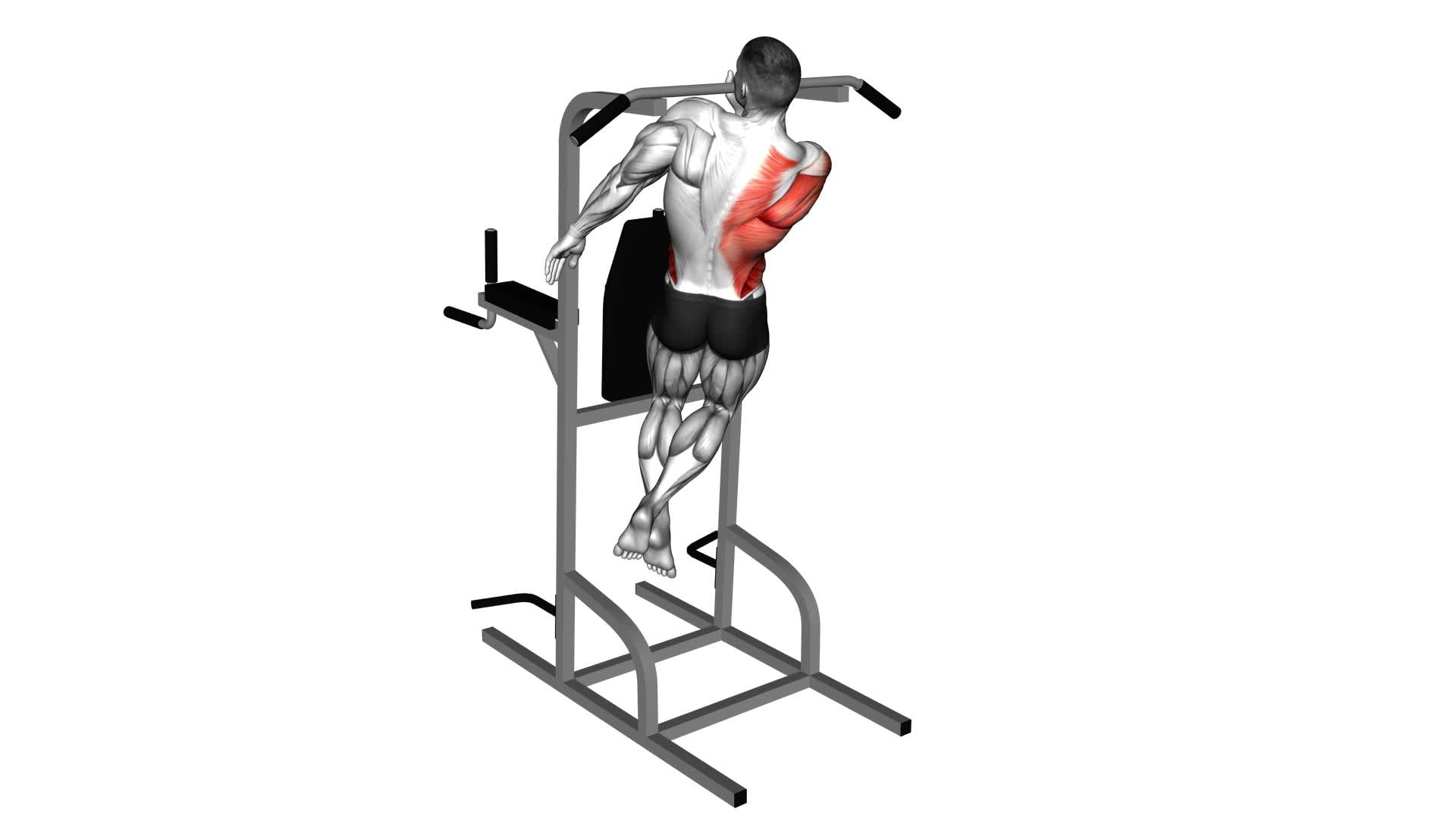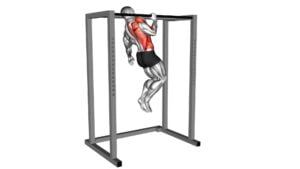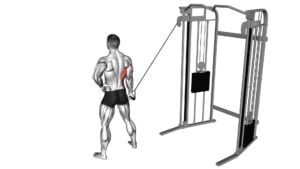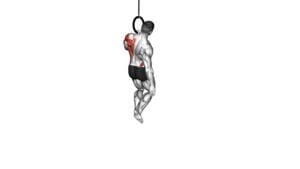Single Arm Pull-up (male) – Video Exercise Guide & Tips

Looking to challenge yourself and take your upper body strength to new heights?
Watch This Exercise Video
In this video exercise guide, we've got you covered with tips and techniques for mastering the single arm pull-up.
Whether you're a beginner or looking to increase your strength and reps, we've got the knowledge and expertise to help you achieve your goals.
Watch the video, follow our advice, and get ready to conquer this impressive exercise.
Key Takeaways
- The single arm pull-up enhances upper body strength and builds functional muscle.
- It improves grip strength and offers a wide range of variations.
- Proper form and technique, such as engaging core muscles and avoiding swinging, are crucial for performing the exercise effectively.
- Beginners can start with assisted pull-ups or resistance band variations and gradually decrease assistance to increase difficulty.
Benefits of the Single Arm Pull-up
To enhance your upper body strength and build functional muscle, incorporating the Single Arm Pull-up into your workout routine offers numerous benefits.
One of the key advantages of this exercise is that it helps to improve grip strength. Maintaining a strong grip is essential not only for performing the Single Arm Pull-up but also for many other daily activities and sports. By challenging your grip during this exercise, you'll develop the muscles in your hands and forearms, allowing you to have a stronger and more secure grip in various situations.
Another benefit of the Single Arm Pull-up is the wide range of variations it offers. This exercise can be modified to suit your fitness level and goals. If you're just starting out, you can use assistance bands or a pulley system to reduce the weight you're pulling and gradually work your way up to a full Single Arm Pull-up. Alternatively, if you're more advanced, you can add additional weight to increase the intensity and further strengthen your muscles.
Incorporating the Single Arm Pull-up into your workout routine can be a game-changer for your upper body strength and overall fitness. By focusing on grip strength and exploring different variations of this exercise, you'll be able to challenge yourself, build functional muscle, and achieve your fitness goals.
Proper Form and Technique
To maintain proper form and technique during the Single Arm Pull-up, focus on engaging your core and maintaining a strong grip on the bar. Here are some important tips to help you perform this challenging exercise correctly:
- Engage your core: Keep your abdominal muscles tight throughout the movement to provide stability and prevent excessive swinging.
- Maintain a strong grip: Make sure to wrap your fingers around the bar and squeeze it tightly. This will help you maintain control and prevent slipping.
- Avoid swinging: It's common to see people using momentum to complete the Single Arm Pull-up. However, this reduces the effectiveness of the exercise and increases the risk of injury. Focus on using your back muscles to perform the movement instead.
Common misconceptions about the Single Arm Pull-up include the belief that it requires superhuman strength. While it's a demanding exercise, with proper progression and training, anyone can work towards achieving it.
Variations and modifications can be made to suit your current fitness level. You can start by using an assisted pull-up machine or resistance bands to lessen the load on your arm. As you build strength, you can gradually decrease the assistance until you can perform the Single Arm Pull-up unassisted.
Progression Exercises for Beginners
Start with assisted pull-ups or resistance band variations to build strength and progress towards the Single Arm Pull-up. These beginner modifications are essential for developing the necessary upper body and core strength required for this advanced exercise. Assisted pull-ups can be performed using a pull-up assist machine or with a partner providing assistance by lightly supporting your legs or hips. Resistance band variations involve looping a resistance band around the pull-up bar and placing one foot or knee in the band to reduce the amount of bodyweight you need to lift.
To perform assisted pull-ups, grip the bar with an overhand grip, shoulder-width apart. Lower yourself down until your arms are fully extended, then use your upper body and core strength to pull yourself up until your chin is above the bar. Repeat for the desired number of repetitions.
For resistance band variations, follow the same grip and form as the assisted pull-up. The resistance band will provide support as you pull yourself up, making it easier to perform the exercise. Gradually reduce the assistance provided by the band over time to gradually increase the difficulty.
No additional equipment is needed for assisted pull-ups, but for resistance band variations, you'll need a resistance band and a pull-up bar.
By starting with these progression exercises, you can gradually build the strength and technique required for the Single Arm Pull-up. Once you have mastered these beginner modifications, you can move on to more advanced variations.
Now, let's delve into the common mistakes to avoid when performing the Single Arm Pull-up.
Common Mistakes to Avoid
As you progress towards the Single Arm Pull-up, it's important to be mindful of common mistakes to avoid. By being aware of these errors, you can ensure that you're performing the exercise correctly, avoiding injury and maximizing your results. Here are some common misconceptions to watch out for:
- Using momentum: One mistake many people make is using momentum to complete the movement. Instead, focus on maintaining control and engaging your muscles throughout the entire range of motion.
- Neglecting proper form: Another common mistake is sacrificing form for the sake of completing more reps. It's crucial to maintain proper form to target the correct muscles and prevent injury.
- Not warming up adequately: Many individuals fail to warm up properly before attempting the Single Arm Pull-up. This can lead to muscle strains and other injuries. Make sure to warm up your muscles and joints before starting the exercise.
By avoiding these common mistakes, you'll be able to perform the Single Arm Pull-up more effectively and reduce the risk of injury.
Now, let's move on to the next section, where we'll discuss some tips for increasing your strength and reps.
Tips for Increasing Strength and Reps
To increase your strength and reps for the Single Arm Pull-up, focus on targeted muscle training and gradual progression.
Increasing the difficulty of your workouts is essential for building strength and improving your performance. Start by incorporating exercises that target the specific muscles used in the Single Arm Pull-up, such as the lats, biceps, and forearms. Pull-ups with both arms can help you build the necessary strength before progressing to the single-arm variation. Additionally, incorporating exercises like bent-over rows, chin-ups, and weighted pull-ups can further develop the muscles needed for the Single Arm Pull-up.
Muscle activation is crucial for increasing strength and reps. Engage the targeted muscles throughout each repetition by consciously activating them. This will ensure that you're maximizing the effectiveness of your training. It's also important to maintain proper form throughout the exercise, as this will help prevent injuries and optimize muscle activation.
Gradual progression is key to building strength and increasing reps. Start with a weight or resistance level that challenges you but still allows you to perform the exercise with proper form. As you become comfortable with the exercise, gradually increase the weight or resistance to continue challenging your muscles. Consistency is also important; aim to train the Single Arm Pull-up regularly to build strength and increase your reps over time.
Frequently Asked Questions
How Long Does It Take to Master the Single Arm Pull-Up?
To master the single arm pull-up, it takes time and consistent effort. Progression strategies, like starting with assisted pull-ups and gradually reducing assistance, can help you build the necessary strength.
Avoid common mistakes such as relying too much on momentum or neglecting proper form. It's important to listen to your body and not rush the process.
With dedication and patience, you can eventually conquer the single arm pull-up and achieve impressive upper body strength.
Are There Any Specific Muscles That the Single Arm Pull-Up Targets?
The single arm pull-up targets several specific muscles in your upper body. It primarily works your latissimus dorsi, which is the largest muscle in your back. It also engages your biceps, forearms, and shoulders. By performing this exercise, you can develop a strong and balanced upper body.
If you find the single arm pull-up challenging, there are alternative exercises you can try, such as assisted single arm pull-ups or single arm lat pulldowns. These exercises will still provide you with the benefits of building overall upper body strength.
Can the Single Arm Pull-Up Be Modified for Individuals With Shoulder Injuries?
If you have a shoulder injury, don't worry, there are modifications you can make to the single arm pull-up.
You can try using a resistance band to assist you in the movement, gradually decreasing the assistance as you get stronger.
Another option is to do assisted one-arm pull-ups using a suspension trainer or a pull-up machine.
Remember to consult with a professional before attempting any exercise modifications.
Is It Necessary to Have a Certain Level of Strength Before Attempting the Single Arm Pull-Up?
Before attempting the single arm pull-up, it's important to have a certain level of strength. This exercise requires a significant amount of upper body and core strength.
To prepare, focus on exercises that target these areas, such as pull-ups, push-ups, and planks. Additionally, use progression techniques to gradually increase your strength and build up to the single arm pull-up.
Are There Any Alternative Exercises That Can Help Improve the Strength Needed for the Single Arm Pull-Up?
To improve the strength needed for the single arm pull-up, there are alternative exercises and progression methods you can try. By incorporating exercises like assisted one-arm pull-ups, negative one-arm pull-ups, and archer pull-ups, you can gradually build the necessary strength.
These exercises target the muscles involved in the single arm pull-up and help you progress towards achieving this challenging exercise. Remember to start with proper form and gradually increase the difficulty as you get stronger.
Conclusion
In conclusion, the single arm pull-up is a challenging exercise that offers numerous benefits, including increased upper body strength and improved grip.
By following proper form and technique, beginners can progress through a series of exercises to build up their strength and eventually achieve this impressive feat.
It's important to avoid common mistakes and focus on increasing strength and reps over time.
With dedication and consistency, anyone can master the single arm pull-up and reap its rewards.

Author
Years ago, the spark of my life’s passion ignited in my mind the moment I stepped into the local gym for the first time. The inaugural bead of perspiration, the initial endeavor, the very first surge of endorphins, and a sense of pride that washed over me post-workout marked the beginning of my deep-seated interest in strength sports, fitness, and sports nutrition. This very curiosity blossomed rapidly into a profound fascination, propelling me to earn a Master’s degree in Physical Education from the Academy of Physical Education in Krakow, followed by a Sports Manager diploma from the Jagiellonian University. My journey of growth led me to gain more specialized qualifications, such as being a certified personal trainer with a focus on sports dietetics, a lifeguard, and an instructor for wellness and corrective gymnastics. Theoretical knowledge paired seamlessly with practical experience, reinforcing my belief that the transformation of individuals under my guidance was also a reflection of my personal growth. This belief holds true even today. Each day, I strive to push the boundaries and explore new realms. These realms gently elevate me to greater heights. The unique combination of passion for my field and the continuous quest for growth fuels my drive to break new ground.







